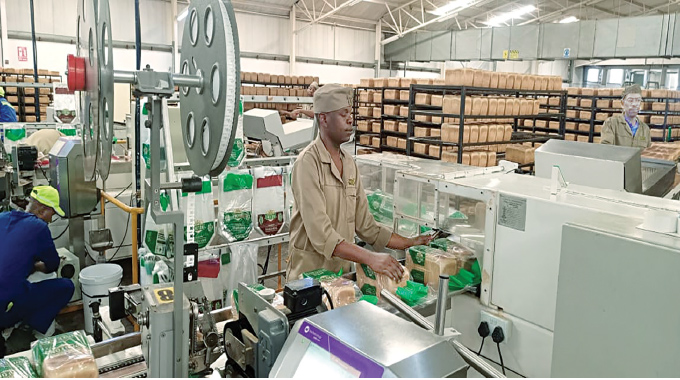Agriculture Column: Biodiversity in organic farming

Tapuwa Mashangwa
SINCE 1990 the market for organic food and other products has grown rapidly, reaching $63 billion worldwide in 2012. According to Helga Willer, Julia Lernoud and Robert Home in their research report:
The World of Organic Agriculture: Statistics & Emerging Trends 2013, as of 2011, approximately 37,000,000 hectares (91,000,000 acres) worldwide were farmed organically, representing approximately 0.9 percent of total world farmland.
This demand has driven a similar increase in organically managed farmland that grew from 2001 to 2011 at a compounding rate of 8.9 percent per annum. As of 2011, approximately 37,000,000 hectares (91,000,000 acres) worldwide were farmed organically, representing approximately 0.9 percent of total world farmland.
Organic farming is a form of agriculture that relies on sustainable techniques to enhance the natural fertility of a farm, including crop rotation, companion planting, biological pest control, and naturally-sourced fertilisers such as compost, manure, green manure, and bone meal.
Pest-control measures such as mixed crops and fostering natural insect predators, as well as naturally-sourced pesticides such as pyrethrin, are employed, while it excludes orBIO strictly limits the use of synthetic petrochemical fertilisers and pesticides, plant growth regulators such as hormones, antibiotic use in livestock, genetically modified organisms; human sewage sludge, and nanomaterials.
The agricultural approach emphasises sustainability, openness, independence, health, and safety.
The conservation of natural resources and biodiversity is a core principle of organic production. Three broad management practices (prohibition/reduced use of chemical pesticides and inorganic fertilisers; sympathetic management of non-cropped habitats; and preservation of mixed farming) that are largely intrinsic (but not exclusive) to organic farming are particularly beneficial for farmland wildlife.
In a research report by DG Hole, Does organic farming benefit biodiversity? using practices that attract or introduce beneficial insects, provide habitat for birds and mammals, and provide conditions that increase soil biotic diversity serve to supply vital ecological services to organic production systems.
Advantages to certified organic operations that implement these types of production practices include: decreased dependence on outside fertility inputs; reduced pest management costs; more reliable sources of clean water; and better pollination.
Nearly all non-crop, naturally occurring species observed in comparative farm land practice studies show a preference for organic farming both by abundance and diversity.
An average of 30 percent more species inhabit organic farms. Birds, butterflies, soil microbes, beetles, earthworms, spiders, vegetation, and mammals are particularly affected.
Lack of herbicides and pesticides improve biodiversity fitness and population density. Many weed species attract beneficial insects that improve soil qualities and forage on weed pests.
Soil-bound organisms often benefit because of increased bacteria populations due to natural fertiliser such as manure, while experiencing reduced intake of herbicides and pesticides.
Increased biodiversity, especially from beneficial soil microbes and mycorrhizae have been proposed as an explanation for the high yields experienced by some organic plots, especially in light of the differences seen in a 21-year comparison of organic and control fields.
Biodiversity from organic farming provides capital to humans. Species found in organic farms enhance sustainability by reducing human input (e.g., fertilisers, pesticides).
A wide range of organisms benefit from organic farming, but it is unclear whether organic methods confer greater benefits than conventional integrated agri-environmental programmes.
Organic farming is often presented as a more biodiversity-friendly practice, but the generality of the beneficial effects of organic farming is debated as the effects appear often species – and context-dependent, and current research has highlighted the need to quantify the relative effects of local- and landscape-scale management on farmland biodiversity.
Laura Henckel, in the research, “organic fields sustain weed meta-community dynamics in farmland landscapes”, states that there are four key issues when comparing the impacts on biodiversity of organic and conventional farming: It remains unclear whether a holistic whole-farm approach (that is organic) provides greater benefits to biodiversity than carefully targeted prescriptions applied to relatively small areas of cropped and/or non-cropped habitats within conventional agriculture (that is agri-environment schemes).
Many comparative studies encounter methodological problems, limiting their ability to draw quantitative conclusions. Our knowledge of the impacts of organic farming in pastoral and upland agriculture is limited.
There remains a pressing need for longitudinal, system-level studies in order to address these issues and to fill in the gaps in our knowledge of the impacts of organic farming, before a full appraisal of its potential role in biodiversity conservation in agro-ecosystems can be made.
Organic agricultural methods are internationally regulated and legally enforced by many nations, based in large part on the standards set by the International Federation of Organic Agriculture Movements (IFOAM), an international umbrella organisation for organic farming organisations established in 1972.
The writer is Engineer Tapuwa Justice Mashangwa, a young entrepreneur based in Bulawayo, Founder and CEO of Emerald Agribusiness Consultancy. He can be contacted on +263739096418 and email: [email protected]











Comments